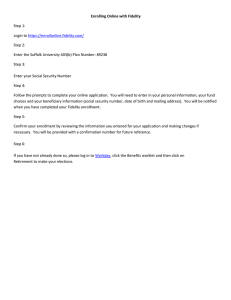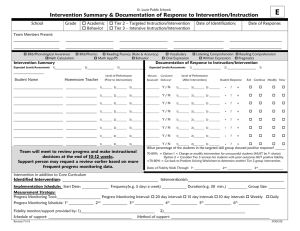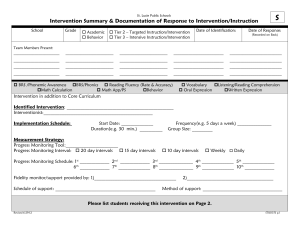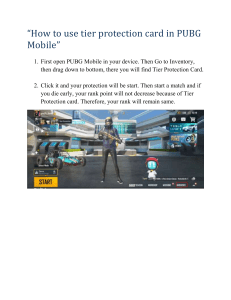2c - School Level Intervention Mapping Tool for MV2 Final (5)
advertisement
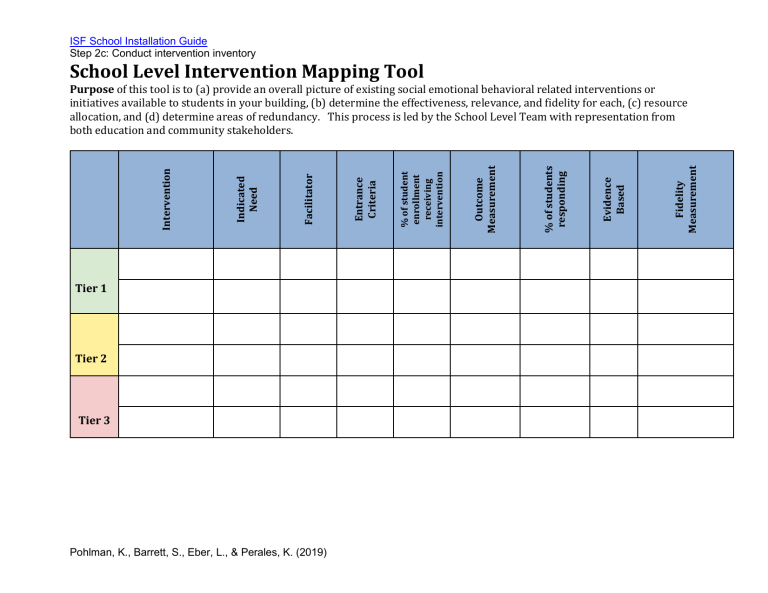
ISF School Installation Guide Step 2c: Conduct intervention inventory School Level Intervention Mapping Tool Tier 1 Tier 2 Tier 3 Pohlman, K., Barrett, S., Eber, L., & Perales, K. (2019) Fidelity Measurement Evidence Based % of students responding Outcome Measurement % of student enrollment receiving intervention Entrance Criteria Facilitator Indicated Need Intervention Purpose of this tool is to (a) provide an overall picture of existing social emotional behavioral related interventions or initiatives available to students in your building, (b) determine the effectiveness, relevance, and fidelity for each, (c) resource allocation, and (d) determine areas of redundancy. This process is led by the School Level Team with representation from both education and community stakeholders. ISF School Installation Guide Step 2c: Conduct intervention inventory Example of School Intervention Map Tier 1 All Time out of class Time out of class reduced by 10% Yes Measured by weekly walkthroughs Classroom Community Circles Increased community and safety perceptions Social Worker None - all students All Student Climate Survey Student Climate Survey increased by 13% No Measured by weekly walkthroughs Check-in, Check-out Low level behavioral needs • 2 major ODRs • 1 suspension • 5 nurse visits in 2 weeks Resource Officer 1 suspension 2 ODRs Low elevation on screener 12% of student enrollment Daily progress report 74% of students responding Yes CICO - Fidelity Implementation Measure Problem Solving Skills Group Anger Management, problem solving skills Social Worker No response to CICO Suspension for physical aggression Teacher or family referral 5% of student enrollment Daily Progress Report & no new Office Discipline Referrals 70% of students responding Yes – reteachin g skills from Tier 1 None Divorce Group Support for students of Social Worker Teacher or family 1% of student Unknown Unknown No None Tier 2 Pohlman, K., Barrett, S., Eber, L., & Perales, K. (2019) Fidelity Measurement % of students responding None - all students Evidence Based Outcome Measurement Counselor % of student enrollment receiving intervention Increased social emotional behavioral instructional time Entrance Criteria Facilitator Social Emotional Behavioral Skills Curriculum Intervention Indicated Need * Items indicated in red are “flagged” for conversation and action to be taken by school team. ISF School Installation Guide Step 2c: Conduct intervention inventory parental divorce Tier 3 referral enrollment Trauma Informed Evidence Based Group Prevent fight, flight, freeze response per risk indications in screening data Communit y Clinician No response to CICO Highly elevated on universal screener 2% of student enrollment Wraparound Students with needs across home-schoolcommunity School Social Worker & Communit y Clinician No response to two Tier 2 interventio ns At-risk for change in placement Highly elevated on universal screener 2% of student enrollment Daily progress report Time out of class Individualized per student 75% of students responding Yes Evidence Based Group Fidelity Tool 72% of students responding Yes Wraparound Integrity Tool Discussions for School Team Based Upon Example: Discussion Item Utilizing school based clinicians to facilitate Tier 1 practices (e.g.: teaching SEB skills curriculum, Classroom Community Circles) Decision Need to build the capacity of teachers to teach SEB skills and facilitate Circles Pohlman, K., Barrett, S., Eber, L., & Perales, K. (2019) Action Steps Provide professional development to staff on clinician skills being utilized at higher tiers to provide “why” Survey staff for current skill and needs Create gradual release process for teachers implementing Tier 1 practices ISF School Installation Guide Step 2c: Conduct intervention inventory Lack of fidelity for Classroom Community Circles No fidelity measure for Problem Solving Skills Group Divorce Group Keep practice due to promising practice and research in juvenile justice field. Continue to track data on impact. The group is producing outcomes and uses evidence-based features. Keep practice and create fidelity measure. Due to multiple factors (e.g.: lack of data, evidence base) not in place with group, the group will be removed from continuum of supports. Pohlman, K., Barrett, S., Eber, L., & Perales, K. (2019) Facilitator with support from District PBIS Coach create a fidelity checklist to be completed every 6 weeks Consider adding a coping skills group utilizing SEB lessons taught at Tier 1
